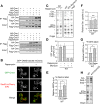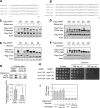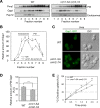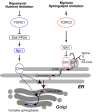TORC1-regulated protein kinase Npr1 phosphorylates Orm to stimulate complex sphingolipid synthesis
- PMID: 23363605
- PMCID: PMC3596256
- DOI: 10.1091/mbc.E12-10-0753
TORC1-regulated protein kinase Npr1 phosphorylates Orm to stimulate complex sphingolipid synthesis
Abstract
The evolutionarily conserved Orm1 and Orm2 proteins mediate sphingolipid homeostasis. However, the homologous Orm proteins and the signaling pathways modulating their phosphorylation and function are incompletely characterized. Here we demonstrate that inhibition of nutrient-sensitive target of rapamycin complex 1 (TORC1) stimulates Orm phosphorylation and synthesis of complex sphingolipids in Saccharomyces cerevisiae. TORC1 inhibition activates the kinase Npr1 that directly phosphorylates and activates the Orm proteins. Npr1-phosphorylated Orm1 and Orm2 stimulate de novo synthesis of complex sphingolipids downstream of serine palmitoyltransferase. Complex sphingolipids in turn stimulate plasma membrane localization and activity of the nutrient scavenging general amino acid permease 1. Thus activation of Orm and complex sphingolipid synthesis upon TORC1 inhibition is a physiological response to starvation.
Figures







Similar articles
-
Protein kinase Ypk1 phosphorylates regulatory proteins Orm1 and Orm2 to control sphingolipid homeostasis in Saccharomyces cerevisiae.Proc Natl Acad Sci U S A. 2011 Nov 29;108(48):19222-7. doi: 10.1073/pnas.1116948108. Epub 2011 Nov 11. Proc Natl Acad Sci U S A. 2011. PMID: 22080611 Free PMC article.
-
Orm proteins integrate multiple signals to maintain sphingolipid homeostasis.J Biol Chem. 2013 Jul 12;288(28):20453-63. doi: 10.1074/jbc.M113.472860. Epub 2013 Jun 4. J Biol Chem. 2013. PMID: 23737533 Free PMC article.
-
The structure of the Orm2-containing serine palmitoyltransferase complex reveals distinct inhibitory potentials of yeast Orm proteins.Cell Rep. 2024 Aug 27;43(8):114627. doi: 10.1016/j.celrep.2024.114627. Epub 2024 Aug 20. Cell Rep. 2024. PMID: 39167489
-
Orm/ORMDL proteins: Gate guardians and master regulators.Adv Biol Regul. 2018 Dec;70:3-18. doi: 10.1016/j.jbior.2018.08.002. Epub 2018 Aug 31. Adv Biol Regul. 2018. PMID: 30193828 Free PMC article. Review.
-
Functions and metabolism of sphingolipids in Saccharomyces cerevisiae.Prog Lipid Res. 2006 Nov;45(6):447-65. doi: 10.1016/j.plipres.2006.03.004. Epub 2006 Apr 21. Prog Lipid Res. 2006. PMID: 16730802 Review.
Cited by
-
Sphingolipid De Novo Biosynthesis: A Rheostat of Cardiovascular Homeostasis.Trends Endocrinol Metab. 2016 Nov;27(11):807-819. doi: 10.1016/j.tem.2016.07.005. Epub 2016 Aug 22. Trends Endocrinol Metab. 2016. PMID: 27562337 Free PMC article. Review.
-
Systematic lipidomic analysis of yeast protein kinase and phosphatase mutants reveals novel insights into regulation of lipid homeostasis.Mol Biol Cell. 2014 Oct 15;25(20):3234-46. doi: 10.1091/mbc.E14-03-0851. Epub 2014 Aug 20. Mol Biol Cell. 2014. PMID: 25143408 Free PMC article.
-
Taming the sphinx: Mechanisms of cellular sphingolipid homeostasis.Biochim Biophys Acta. 2016 Aug;1861(8 Pt B):784-792. doi: 10.1016/j.bbalip.2015.12.021. Epub 2015 Dec 30. Biochim Biophys Acta. 2016. PMID: 26747648 Free PMC article. Review.
-
Pib2 and the EGO complex are both required for activation of TORC1.J Cell Sci. 2017 Nov 15;130(22):3878-3890. doi: 10.1242/jcs.207910. Epub 2017 Oct 9. J Cell Sci. 2017. PMID: 28993463 Free PMC article.
-
Accumulation of long-chain bases in yeast promotes their conversion to a long-chain base vinyl ether.J Lipid Res. 2016 Nov;57(11):2040-2050. doi: 10.1194/jlr.M070748. Epub 2016 Aug 25. J Lipid Res. 2016. PMID: 27561298 Free PMC article.
References
-
- Arndt KT, Styles CA, Fink GR. A suppressor of a HIS4 transcriptional defect encodes a protein with homology to the catalytic subunit of protein phosphatases. Cell. 1989;56:527–537. - PubMed
Publication types
MeSH terms
Substances
LinkOut - more resources
Full Text Sources
Other Literature Sources
Molecular Biology Databases
Miscellaneous

